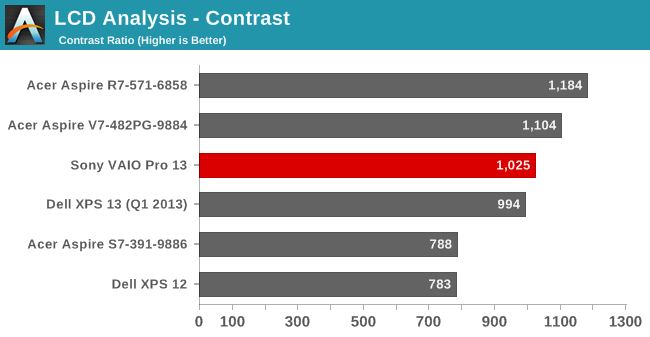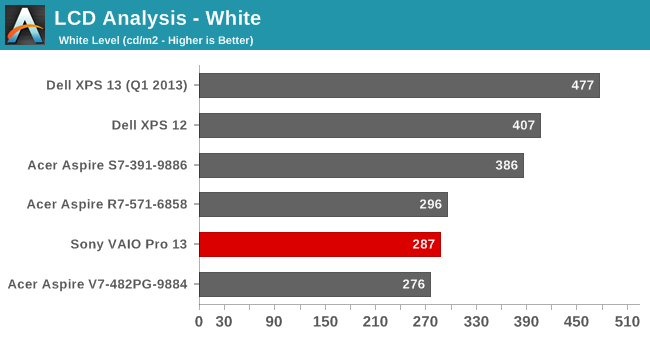Sony VAIO Pro 13: Exceptionally Portable
by Jarred Walton on October 16, 2013 12:00 AM ESTA Great Display
Wrapping up our testing, we have the display along with some figures for temperatures and noise levels. Starting with the display, I actually have a problem with my i1 Display2 colorimeter – it reports numbers, but the calibration is all messed up. I have another colorimeter, an older DTP-94 that still works well, but it doesn't work with ColorEyes Display Pro under 64-bit Windows. What I ended up doing was measuring the white and black levels with the DTP-94 using a separate PC (an old laptop running Windows XP), which also give me contrast, but I don't have Delta E or gamut numbers right now.
At some point we will be moving towards a better test regimen for laptop displays, similar to what we do on tablets and smartphones. Most users don't have a colorimeter, so the out-of-box experience is far more important than the calibrated result – and nearly all displays calibrate fairly well. This will hopefully help to encourage the laptop manufacturers to put more effort into delivering good quality calibrated displays, similar to what we've seen from Apple with their latest iPad, iPhone, iMac, and MacBook Retina products. And with that said, here are the brightness and contrast graphs.



The VAIO Pro 13 has a reasonably bright backlight, but we still would like to see maximum white levels of 400 nits, as that helps with outdoor use. This laptop is so targeted at mobility that the lack of a brighter display could definitely be seen as a drawback. As for black levels and the resulting contrast, the LCD does very well, with a contrast ratio of over 1000:1. Acer's S7 potentially has a slightly better display, based on these results, but I think the colors on the Sony are actually a bit better and hopefully I can get the colorimeter situation sorted out soon enough to update this section. Anyway, I do like the Sony display quite a lot and think it's one of the best aspects of the VAIO Pro 13.
Temperatures and Noise Levels
Considering the apparent throttling that was taking place in some tests – at the very least the CPU/GPU are not running anywhere near maximum Turbo speeds – I was curious to see what the temperatures looked like under load. We've seen many an Ultrabook hit 90C or higher under load, but Sony bucks that trend in a serious way. I don't think it's just the cooling either, as the laptop doesn't get exceptionally loud. Instead, it's Sony's firmware favoring lower Turbo Boost levels in order to keep temperatures down. Here's what we found in our stress testing:

After running our stress test all night (and then some), the maximum package temperature ended up at just 76C. That's a result more than a few desktops would be happy to equal, and we're dealing with an extremely thin chassis. Even the airflow from the vent on the side doesn't feel that hot, and covering it with my hand didn't get uncomfortable – and it didn't increase the noise levels or temperatures either! Instead, clock speeds dropped slightly and the system continued chugging happily along at 76C or less.
As for noise levels, at idle and light loads the fan is off and thus the VAIO Pro 13 is completely silent. Once the CPU temperature hits I think 40C or more, the fan begins to spin, and in most cases it will be at the minimum speed, which results in a noise level of 32dB from a distance of around 18 inches (45cm). The fan speed and resulting noise levels begin ramping up until the fan is running at maximum at 50C or higher, with a resulting noise level of 42dB. It's a gradual ramp in fan speed as well, which is nice to see – a lot of laptops have three or four discrete speeds with a substantial difference in noise levels at each speed. Considering this isn't really a laptop designed for complex computational tasks (not that it can't do some of them, but it's no mobile workstation), most users will find the laptop typically runs at very low fan speeds or even silently.


_thumb.JPG)
_thumb.JPG)
_thumb.JPG)
_thumb.JPG)
_thumb.JPG)
_thumb.jpg)








106 Comments
View All Comments
JarredWalton - Wednesday, October 16, 2013 - link
Yes, pretty much what you said. There's some VAIO utilities, but they're not too obtrusive and I like some of the features the VAIO Care Center offers (it gives reasonably detailed control over the various settings like the keyboard backlighting among other things). I also uninstalled the McAfee software (we always test without any Firewall enabled and no anti-virus software running, just for consistency). I personally have been using Microsoft Security Essentials on my PCs since it came out and haven't had any problems, but then I avoid the sort of sites that tend to infect PCs so YMMV.jyotib - Wednesday, October 16, 2013 - link
I did buy this machine three months ago, but with a Sony deal that gave a 256GB SSD and 8GB RAM for about the price listed for your review machine. I must say it has been a truly excellent machine for me, as I favour a top flight display, light weight, long battery life and fast operation.The Wi-Fi problem you reference was a real pain, but the Intel driver update has (mostly) sorted it out. It does surface in an unusual way, though. If the machine goes to sleep in one location, and then wakes in a location with a different Wi-Fi router, it does not seem to find it without restarting the Wi-Fi adaptor.
Another update for the display driver now seems to cause the display to get stuck on a low brightness level every now and then - not sure what is going on, as this behaviour was not apparent before the update.
I recognise that the use of carbon fibre has made the Vaio feel flexible, but the design's build quality does not strike me as inadequate in any way. One caveat after 3 months of use is that the keys seem to imprint themselves on the screen so that (at certain angles) I can see key marks on the display. I feel that this is a design problem, caused by the search for a thin device. I did discuss this with Sony and the answer from them was that I needed to use the cloth that came with the device - this black cloth seemed to be part of the packaging but it is quite important, and should not be thrown away. It needs to cover on the keyboard every time you shut the lid. I thought this would be remarkably frustrating and that I would lose the cloth immediately. Somehow, I have got used to it and the cloth is still present three months in. Would I prefer that Sony had sorted out the problem in the design work? Yes, yes.
Overall, I am struck how well my personal experience with the machine reflects the findings of the reviewer. This might be the first time I have read an Anandtech review of a product I already know well - rather than reading about a product I might be considering - and its accuracy in laying out my own use case does encourage me to consider your reviews seriously next time I am seeking a new device. Well done.
monstercameron - Wednesday, October 16, 2013 - link
Jarred why not compare it to a6-5200? the a4-5000 only makes the AMD competition look terrible in comparison.JarredWalton - Wednesday, October 16, 2013 - link
Because we never had one for testing.hughlle - Wednesday, October 16, 2013 - link
I'm just a little comfused by the lack of information in the battery graphs. You might as well just remove the numbers entirely. 959 what's? What am i actually looking at? I can make out the graphs lower down as being rated in hours, but what about the former graphs?JarredWalton - Wednesday, October 16, 2013 - link
They're in minutes... not sure why the subtext no longer says that as I swear it used to be there. I'll fix that....Chrispy_ - Wednesday, October 16, 2013 - link
Mind-boggling expensive for a Dual-core with only 4GB of RAM, a small SSD and the entry-level IGP, portable or not.Is it worth it?
NO. Not even close.
hfm - Wednesday, October 16, 2013 - link
Stop messing around with these other devices and post the p34g review. :)JarredWalton - Wednesday, October 16, 2013 - link
I have to get one other finished first (Clevo W740SU), but the preview should tell you much of what you need to know. I just need to test actually gaming performance and battery life, as well as check for any heat issues. It's a shame their keyboard isn't that great though.hfm - Wednesday, October 16, 2013 - link
How's the cooling system noise under gaming load?